Hundreds of Florida waters are considered “impaired” for fish consumption. As a result the Florida Department of Health advises that most fish caught in the state’s waters shouldn’t be eaten more than twice a week. But that message does not always get through to subsistence fishers.
Marlie Pasilan and her husband settle on the Fort De Soto Gulf Pier as early as 9 a.m. to feed their three children. Her family eats fish like French fries. A hearty wind hits their faces, as ruffled palm leaves clap behind them. Fleeting seagulls steady themselves along the pier’s canopies and atop light poles. Dozens of visitors in fedoras and flip flops stroll in and out of the outstretched walkway, easy targets for the stream of bird waste above.
Along the ledge of the pier, anglers lean up against the railing with stiff 8-foot poles, too taut to budge in the brisk wind. Some fish for sport. Others for sustenance. The Pasilan family are subsistence anglers, who typically fish from Boca Ciega Bay and keep whatever they catch.
“As long as there is meat, we will eat it,” Marlie says.
Subsistence fishing doesn’t just feed the body, it feeds the soul. But the saltwater sustenance also presents an unseen risk.
Boca Ciega is among 17 spots in the Tampa Bay watershed considered “impaired” for fish consumption, according to the U.S. Environmental Protection Agency. Across the state, the Florida Department of Health puts out advisories for how much fish is safe to eat; the agency advises that most fish should be eaten no more than twice a week. But the message does not always get through to subsistence fishers and their families. For the Pasilans, as for other anglers who fish Florida’s waters, it is a nutritional, social and cultural tradition from home — in their case, the fish-filled islands of the Philippines.
She casts one line after the other, reeling them in minutes later to see the squid bait still pierced to the hook. She doesn’t fish freshwater; the catch is bland there, she says. Coasting nearby, a pelican flutters its webbed feet and lurks around her line for lunch. Within seconds, it dunks its beak, then body, into the bay with a single splash in pursuit of the limited prey. Marlie pulls her line in once more: nothing. Whether it was the pelican or a larger fish that snagged her bait, Marlie doesn’t know. Standing about 10 feet away, her husband, Joebert, holds a steady grip. As the tip of his fishing pole takes a sharp nod to the sea, he yanks at the reel, winding his arm clockwise, one spool after the other. A pinfish launches out of the water, propelled by its recoil, and comes to a shaky stop hovering above the pale-cement pier. Joebert reels in another. And then another.
The eight-inch fish was all the Pasilan family could catch that day. Pinfish, striped blue and gold, have a signature dark spot behind their gills, small, sharp teeth and spiked fins. Usually chopped up as bait by neighboring anglers, the family toss every catch into their cooler.
Fresh and saltwater fish are among the largest wild food sources available, yet urban fishing remains underreported, according to an Eckerd College survey. Piers, bridges, seawalls and public parks are important commons for urban fishers, survey authors Noelle Boucquey and Jessie Fly found, and help keep food on the table for many families. Eleven percent of survey respondents reported that fishing kept them from going hungry in the previous year.
Yet anglers often lack access to consumption-risk information. The pier that Marlie and Joebert fish from lacks advisory signs warning fishers of possible mercury contamination. About 77% of Tampa Bay anglers keep the fish they catch, Boucquey and Fly found, and of those, 97% eat the fish.

They don’t hope, they pray
The expert anglers didn’t come that Sunday. They could sense few fish inhabiting the waters, Marlie says. The cool temperature makes the spring Tampa Bay heat bearable for regulars and tourists alike, but chills the water that mackerel, blue runner and ladyfish love. Clear, crystallized waters turn to disturbed, broken waves. The fish dislike the winds, Marlie says. They prefer sticky and stale air. Still, even when the fish were less likely to bite, Marlie and her husband wheeled their wagon to the piers—as often as they could—hoping to prepare a fish dinner.
No one taught Marlie how to fish. She lived in Negros Occidental, a Philippine province in which cities dot the coastline and many people rely on fishing for their livelihood. Frolicking on the edge of the Sulu Sea, she and her friends used to dive into the water with nets, spears or sometimes their bare hands to try and capture a fleshy morsel. Her parents — her mother a teacher and her father a police officer — were often not home, so her sister would cook as she studied. Her sister poured tomatoes, scallions, onions, ginger, garlic and fish into a boiling vinegar and water broth and flavored the stew with salt and pepper. Her husband makes a similar recipe that, to this day, she devours.
A majority of her university classmates moved immediately to the U.S. upon graduation, but Marlie resisted.
“You work like a donkey here,” she says with a laugh.
After trying for a decade to make a living in the Philippines and in Dubai as a nurse, she needed additional money to support her growing family and migrated to Maine in 2016. She moved to Pinellas Park, a city near St. Petersburg, two years later to escape the slow pace and cold weather.
As a traveling nurse currently stationed at Brooksville’s Oak Hill Hospital, Marlie works at least three 12-hour shifts a week, two of which are overnight, fulfilling medications and doctor’s orders. With low staffing levels, she labored in the psychiatric unit in late March and early April. Nurses walked the corridor with bruises along their arm from aggressive patients who bit, grabbed and slapped. All three days she brought to work a sliver of fresh-caught blue runner and waited for the lunchroom to clear before the fragrant odor wafted through the air.
“When I eat my fish, I have to hide,” she says.
Her colleagues had previously gawked and complained not only about the smell but the fish eye that stared back at them as they glanced at her plate. She returned with a tease. Eating fish eyes sharpens your eyesight.
Back at the pier, one desperate pinfish pounds the walls of the cooler every 30 seconds, flapping on the backs of its brethren. They will not bite you, Marlie says. At least 15 pinfish lay flat in the bare icebox, their beady eyes fixated above. Some gutted, others gasped for oxygen. Steel cleaning boards, equipped with faucets, create checkpoints along the pier for fishers to slit the bellies and spoon out the insides of their catches.
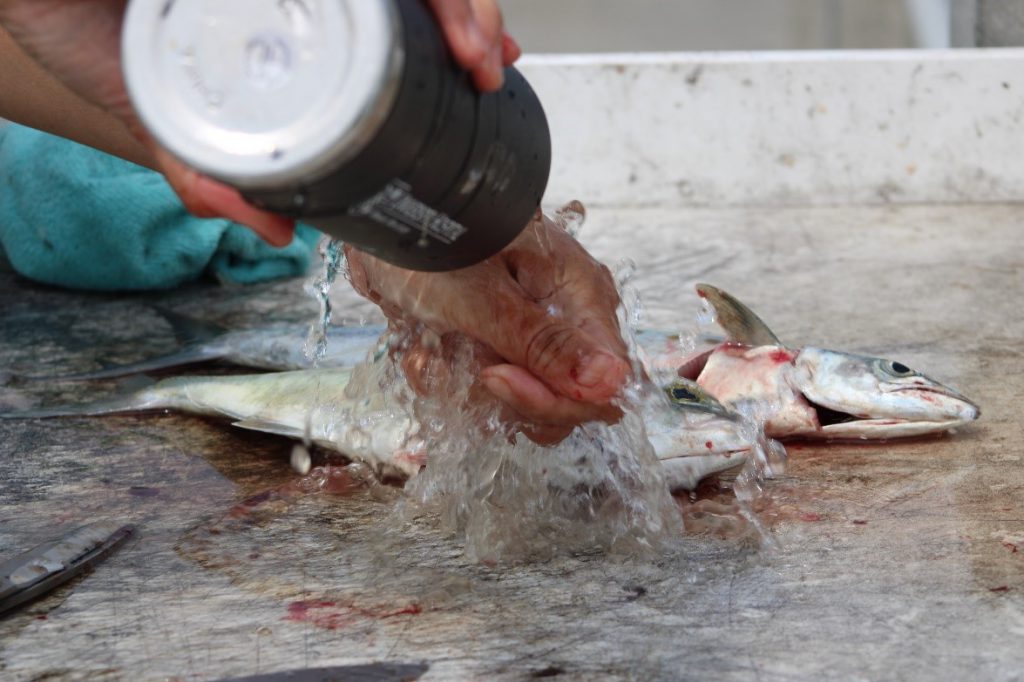
Within the next 12 hours, if their fate wasn’t frozen or fried, the fish were balled and plopped into wonton soup, stewed with onions, tomatoes and moringa leaves or dried into a crispy chip. The family’s catches range from sardines to Spanish mackerel, a gold-speckled fish that hangs around reefs and grass beds. The Department of Health advises that the consumption of just two pinfish in a given week could heighten mercury contamination risk for women of childbearing age and children, present in most Florida seafood.
Generally, though, the fish to worry about are larger species such as king mackerel, also found near piers and high in mercury, says Ted Lange, a wildlife biologist with the Florida Fish and Wildlife Conservation Commission.
“It’s generally not big, predatory fish, so that’s good,” Lange says about subsistence angler catches.
Lange advises anglers to catch a variety of fish from different locations. He adds that the state health department’s 83-page fish advisory report, “Your Guide To Eating Fish Caught in Florida,” provides an influx of information and is not user-friendly. The advisory aims to alert anglers about the potential for contaminated fish within Florida waterways.
“This is the most horrible document on the face of the planet,” Lange says. “We’re trying to overcome this, and it’s very challenging.”
When anglers purchase their fishing license, they receive a page on freshwater fishing regulations, Lange says. The Department of Health also provides wallet card print outs online with condensed fish consumption guidelines.
“I don’t think this is fairly straightforward, but we always strive to do better,” he says.
Marlie is unfamiliar with most consumption guidelines; her husband relies on instinct.
“It comes from the water and the sea, it’s safe,” she says.
She thrusts her line again, a sorrowful eight feet from the railing. Although she fishes alongside her husband, she mostly accompanies him for moral support. The line bobs again. A fish nibbled at her bait and darted away.
“Come on, bite all of it,” she says. “If you bite, bite!”
She’s not good with fish names but keeps any catch that is not too small or bony. Her family doesn’t just hope for ample fish in Tampa Bay. They pray.
A Coastal Love Story
Like a sinkhole, Florida pulls in regional and global sources of mercury. As the potent toxin accumulates in fishes, anglers who consume those with the highest levels face the threat of neurological diseases, brain impairments and related cancers, says University of Florida Fisheries and Aquatic Science professor Mike Allen. Consider a king mackerel that chows on sardines with tiny traces of mercury. Mercury builds up in their fat cells, magnified with every sardine the mackerel eats. The larger and older the fish, the more cautious children and women of childbearing age should be, Allen says. Spanish mackerel can also be high in mercury, but they’re smaller, shorter lived and not as dangerous as the large king mackerel.
“It’s not like if you ate mackerel three times a week you’re guaranteed to get sick,” he says, “but you have an increased probability and because of that, we put out the guidelines.”
Nearby coal-fired power plants have heightened mercury levels in the Tampa Bay region. Tampa Electric Co., which began introducing natural gas turbines in April, relied on coal-fired units for 50 years.
About 80% of fish advisories are reactions to reports of mercury contamination. Razieh Farzad, a UF food science assistant professor, acknowledges that online advisories are not easily accessible for all anglers. But she’s unsure if additional awareness on contaminated fish and waterways will sway anglers who rely on the pier to feed their families.
“Whether they’re going to accept our recommendation or not,” Farzad says, “I think there’s still lots of work to be done.”With food representing culture and emotion as well as substance, Farzad realizes she cannot force anglers to change what they do and don’t eat. Scientists must listen and meet anglers where they are, she says, before suggesting alternatives.
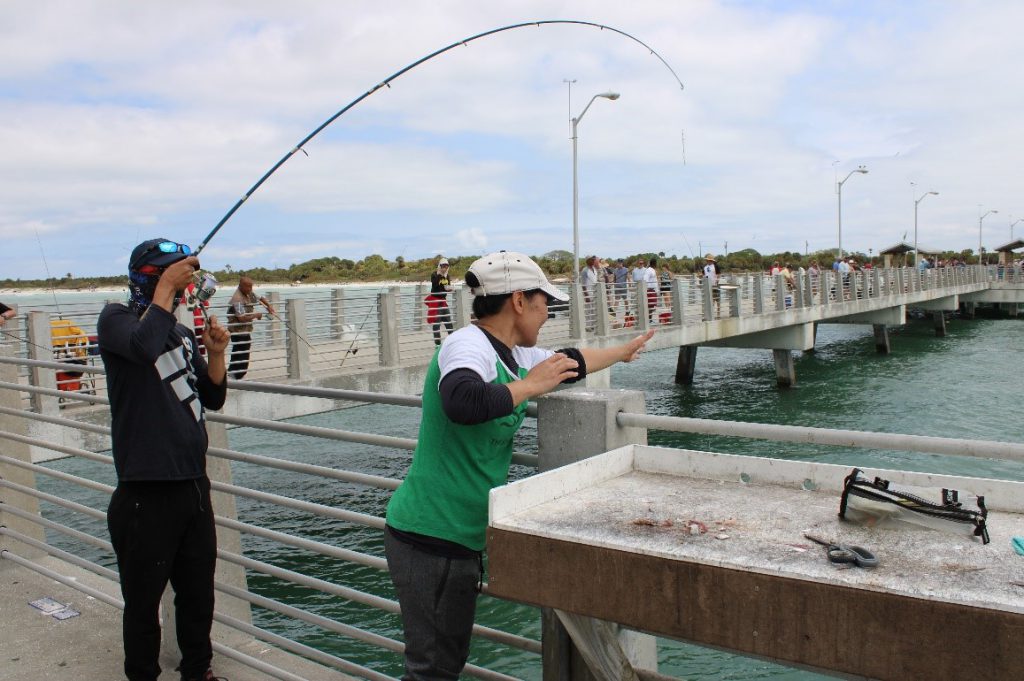
The steaming plate of flaky fish in her Pinellas Park home resembles the home-cooked meals her sister prepared for her as a child. Supported by the pier’s ledge and hugging the fishing pole with her palms, she says Tampa Bay’s water reminds her of home. She met her husband on the sea. He drove a local passenger ship that connected her hometown to the country’s capital, Manila, where she started her nursing career. They met in her early 20s, and he was her fourth cousin on her mom’s side. Initially fraught with tension from her family, she hesitated to go home after work. But her love for him trumped the whispers and finger wags of disapproval.
“Before I was like, I don’t want to go home because people will talk about us,” Marlie says. “Later on, my brain matured. ‘Who cares? You’re not the one feeding us.’”
As her marriage nears the 20-year checkpoint, their love of fish and coastal waters keeps their bond teeming at the brim.
The sweet and savory sound of Hiligaynon departs from Marlie’s lips and salsas into Joebert’s ear. Her husband doesn’t speak English and uses their native, serenade-like dialect to communicate. Its candied lullaby reflects their ever-present love. Even curse words sound sweet, she says. Joebert doesn’t work outside the home. He cooks and cares for their three kids: 18-year-old Jollianne, 11-year-old Jacob and 9-year-old Joellize. He floods his free time with “what to catch” and “where to fish” YouTube videos, and harvesting eggs from the pet chickens Marlie purchased from Ocala.
For women of childbearing age and children, the risk of mercury contamination is higher. In a Duval County study, only 15.7% of anglers were aware of the fish consumption guidelines, and nearly a third of women ate a high-risk fish such as golden snapper, king mackerel and Spanish mackerel within the last two months. All anglers are advised not to eat king mackerel of any size, and women of childbearing age and children can safely eat Spanish mackerel once a month. About three weeks later, Marlie and Joebert caught two.
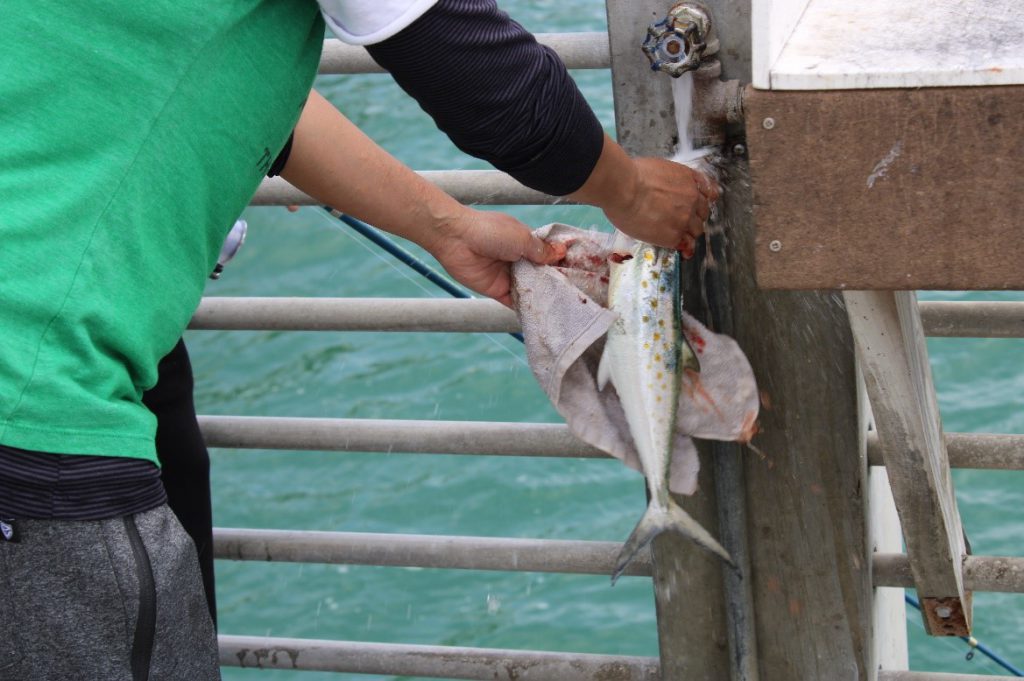
‘God will understand’
Her kids never tire of the saltwater delicacy.
Fried fish, coated in a crunchy, golden batter, rest on the kitchen counter. Beside it lies steaming Sinigang, a sour fish stew made with tamarind or guava powder. Each child snags a piece of the flaky, fried snack their parents leave on the counter with no explanation. At dinner time, Marlie dissects the day’s catch, separating the meat from the bone, and severing the fish’s head. She and her husband always eat the eyes. Her kids refuse. In fact, they can barely peel a banana, she says. At dinner’s end, the sound of pots and pans clashing in the kitchen sink echo throughout the house. Her husband resents cooking, and he wants the house to know.
Joebert seems less concerned about the apparent mercury risk. He believes fish have naturally occurring mercury (they do, in fact) and fresh catches are healthier than greasy, fast-food meals. Seafood is a highly digestible protein that contains Omega-3 fatty acids that help prevent cardiovascular disease and strengthen brain development. As an adult male, he’s also the least vulnerable in his family of five. Despite the risk, she takes his lead.
On another Sunday, Marlie hastily preps a bowl of cereal for her children, hoping the sugary breakfast will hold them until she and Joebert return from the pier. She and he make a pit stop at McDonalds and head off to fish, missing church service.
“God will understand,” she says.
Raised Catholic, she remembers her grandmother counting a string of beads on a rosary for more than half an hour. Marlie says the prolonged prayers felt like a punishment and interfered with her short attention span. The two would rise before the sun for 4 a.m. Sunday service, reiterating the rosary prayer in dainty dresses and concluding the morning with baskets of fresh produce and sweets at the flea market.
“If you think about it, God will throw away all the blessings at 4 a.m.,” her grandmother would say, “so who will be the first one to catch them?”
Marlie prefers to let her children decide on their faith.
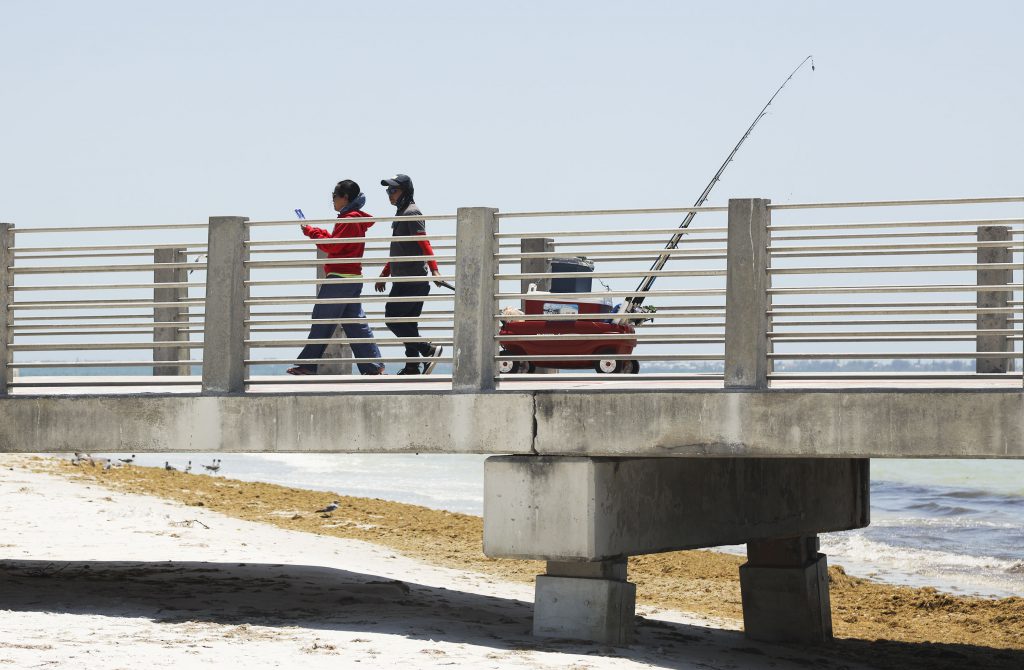
Twenty minutes before 1 p.m., the tip of Joebert’s fishing line bends like a horse shoe. As he begins to reel it in, Marlie stretches out her fingertips to help release the fish. It’s a Spanish mackerel, an essential part of her family’s fish stew recipe. Spanish mackerel, one of the fish the health department advises women of childbearing age and children eat only once a month. She grabs a muddied teal rag and grips the mackerel with both hands. After tossing it in the cooler, she returns to her spot on the pier. Two splotches of fish blood speck her right cheek. Within hours, the maraschino red turns brown. Marlie pulls in a sardine.
“This one is bigger; they don’t catch it,” Marlie says, referring to what other anglers keep. “They want the smaller ones, but for us we make use of everything.”
As the day creeps into the afternoon, heather gray dorsal fins rise from the watr swarming the pier. Some drive in trios, pairs and solo.
“He peeked his head at us,” says a young girl as she grips the edge of the pier like handlebars.
“That was a narwhal!” another girl squealed.
They began to count down: 3, 2, 1, until they’d see another dolphin.
They’re getting lazy, Marlie says, referring to the dolphins. They could have easily caught the fish on their own but instead lap around the pier, engulfing the mackerel dumb enough to fall for bait.
Two Vietnamese women dominate the left end of the pier. As soon as their pole bobs, they know they made a catch that the dolphins crave. They turn from the ledge and dart to the opposite end, their fishing line above their heads. A man jolts the line from the water as the woman reaches the halfway point of the pier.
A Spanish mackerel slaps the pavement. This time the Vietnamese angler won. Within minutes, she gets another bite and darts to the opposing end of the pier.
Local anglers erupt in a manufactured laugh. It happens again, only Marlie begins to reel in the line, her left arm immediately following her right like a game of tug of war. It is a game of tug of war. Guests watch as the outline of the dolphin maneuvers closer to the line. It snaps at the shimmering fish and flicks its tail in defiance. This time the dolphin won. With the hook still in its mouth, her line begins to recoil. At about 3 p.m., at least two 12-inch Spanish mackerel lay in the cooler. When she and Joebert arrive home, he plans to grill them. While the oceans may not be pristine, they cannot stay away. She’s already focused on the next time she and her husband will return to their beloved Fort De Soto pier to catch their next saltwater meal.
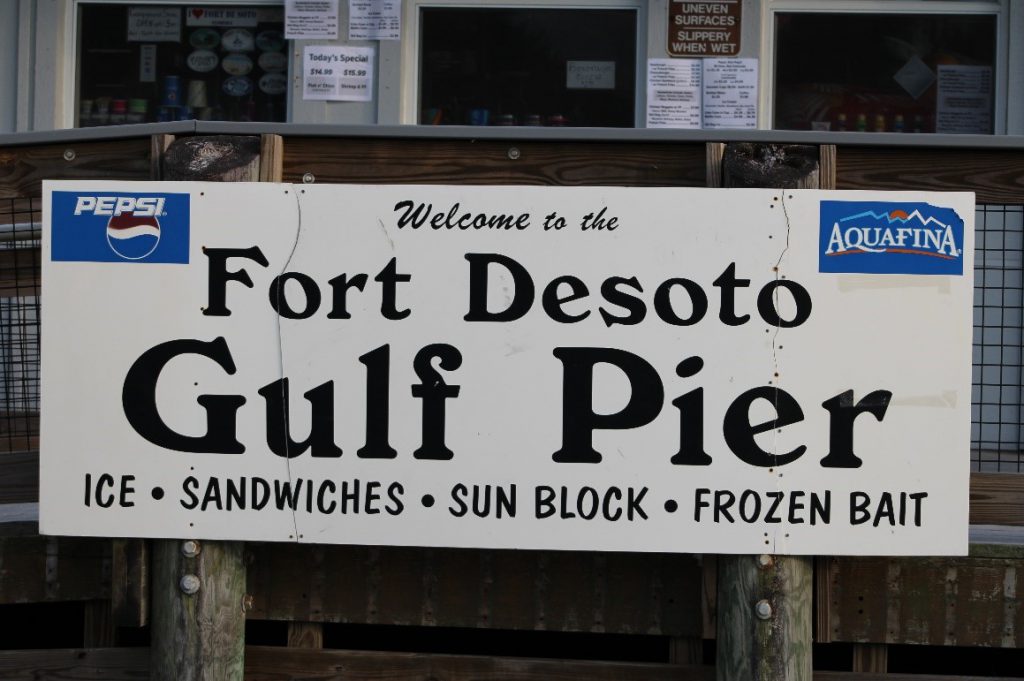
This story is part of the UF College of Journalism and Communications’ series WATERSHED, an investigation into statewide water quality marking the 50th anniversary of the Clean Water Act, supported by the Pulitzer Center’s nationwide Connected Coastlines reporting initiative.
 WATERSHED
WATERSHED